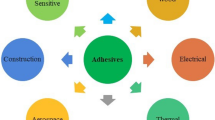Abstract
Nickel-coated graphite particles and two-component silicone-rubber were compounded to form a conductive composite system. The electrical volume resistivity of the composites were examined and compared under constant tensile strains, cyclic heating-cooling, electric field and repeated cyclic tensile strains in order to study the mechanism of electrical conductivity behaviors of the conductive composites under stress, temperature and current. The results showed that a peak value of the electrical resistivity appeared previously and then gradually increasing with increasing tensile strain. The electrical resistivity displayed positive temperature coefficient effect during the temperature increasing and decreasing. Applying 5A direct current to the conductive composites resulted in an increase in the electrical resistance immediately, but no changes were detected under lower currents. Under the repeated cyclic strain, the peak value of the electrical resistivity of each cycle increased with the test cycle. All the electrical resistivity changes were attributed to the conductive networks broken-up and rebuilt in the conductive composites.
Similar content being viewed by others
References
W J Kim, M Taya, M N Nguyen. Electrical and Thermal Conductivities of a Silver Flake/Thermosetting Polymer Matrix Composite[J]. Mech. Mater., 2009, 41(10): 1 116–1 124
Z Q Zhao, X L Zhang. The Technology Application of the Conductive and Antistatic Polymer Materials[M]. Beijing: China Textile & Apparel Press, 2006
I A Mir, D Kumar. Recent Advances in Isotropic Conductive Adhesives for Electronics Packaging Applications[J]. Int. J. Adhes. Adhes., 2008, 28(7): 362–371
I Novák, I Krupa. Electro-conductive Resins Filled with Graphite for Casting Applications[J]. Eur. Polym. J., 2004, 40(7): 1 417–1 422
G H Chen, W G Weng, D Wu, et al. PMMA/Graphite Nanosheet Composite and Its Conducting Properties[J]. Eur. Polym. J., 2003, 39(12): 2 329–2 335
A Takasu, H Itou, M Takada, et al. Accelerated Biodegradation of Poly(vinyl alcohol) by a Glycosidation of the Hydroxyl Groups[J]. Polym., 2002, 43(1): 227–231
S F Hu, C Zhang, M Zhao. Effect of Tensile Strain on the Electrical Resistivity of Silver-coated Fly Ash Cenospheres Silicone-rubber Composites[J]. Polym. Bull., 2011, 66: 955–963
H P Wu, X J Wu, M Y Ge, et al. Effect Analysis of Filler Sizes on Percolation Threshold of Isotropical Conductive Adhesives[J]. Sci. in China Press, 2008, 38(3): 448–454
L Wang, F Li, Z Su. Effective Thermal Conductivity Behavior of Filled Vulcanized Perfluoromethyl Vinyl Ether Rubber[J]. J. Appl. Polym. Sci., 2008, 108(5): 2 968–2 974
F P Liu, M P Wolcott, D J Gardner, et al. Characterization of the Interface Between Cellulosic Fibers and Thermoplastic Matrix[J]. Compos. Interfaces, 1994, 2(6): 419–432
C A Tang, Y F Fu, W C Zhu. Numerical Approach to Effect of Interface Properties on Failure Modes in Particle Filled Composite[J]. Acta Mater. Compos. Sinica, 1999, 16(4):112–120
H Zou, L Zhang, M Tian, et al. Study on the Structure and Properties of Conductive Silicone Rubber Filled with Nickel-coated Graphite[J]. J. Appl. Polym. Sci., 2010, 115(5): 2 710–2 717
J Meyer. Glass Transition Temperature as a Guide to Selection of Polymers Suitable for PTC Material[J]. Polym. Eng. Sci., 1973, 13(6): 462–468
K G Princy, R Joseph, C S Kartha. Studies on Conductive Silicone Rubber Compounds[J]. J. Appl. Polym. Sci., 1998, 69(5): 1 043–1 050
E-S Park, W J Lee, J-S Yoon. Resistivity and Thermal Reproducibility of Carbon Black and Metallic Powder Filled Silicone Rrubber Heaters[J]. J. Appl. Polym. Sci., 2005, 95(5): 1 122–1 128
J Zhang, S Zhang, S Feng, et al. The Correlativity of Positive Temperature Coefficient Effects in Conductive Silicone Rubber[J]. Polym. International, 2005, 54(8): 1 175–1 179
J N Aneli, G E Zaikov, O V Mukbaniani. Electrical Conductivity of Polymer Composites during Mechanical Relaxation[J]. J. Appl. Poly. Sci., 1999, 74: 601–621
I Chodák, I Novák, I Krupa. Electroconductive Adhesives Based on Epoxy and Polyurethane Resins Filled with Silver-coated Inorganic Fillers[J]. Synth. Met., 2004, 144(1): 13–19
W Zheng, S C Wong. Electrical and Dielectric Properties of PMMA/Expanded Graphite Composites[J]. Compos. Sci. Technol., 2003, 63(2): 225–235
G H Chen, D J Wu, W G Weng, et al. Exfoliation of Graphite Flake and Its Nanocomposites[J]. Carbon, 2003, 41(3): 619–621
Z Mo, Y Sun, H Chen, et al. Preparation and Characterization of a PMMA/Ce(OH)3, Pr2O3/Graphite Nanosheet Composite[J]. Polym., 2005, 46(26): 12 670–12 676
X Lu, Y Huang, C Zhang, et al. Investigation on Curing Kinetics and Thermal Properties of a Novel Epoxy Resin System[J]. J. Solid Rocket Technol., 2007, 30(2): 163–166
Author information
Authors and Affiliations
Corresponding author
Additional information
Funded by Wuhan Science and Technology Bureau (No. 200710321090 -18)
Rights and permissions
About this article
Cite this article
Hu, S., Li, H., Chen, X. et al. The electrical conductive effect of nickel-coated graphite/two-component silicone-rubber sealant. J. Wuhan Univ. Technol.-Mat. Sci. Edit. 28, 429–436 (2013). https://doi.org/10.1007/s11595-013-0708-3
Received:
Accepted:
Published:
Issue Date:
DOI: https://doi.org/10.1007/s11595-013-0708-3




